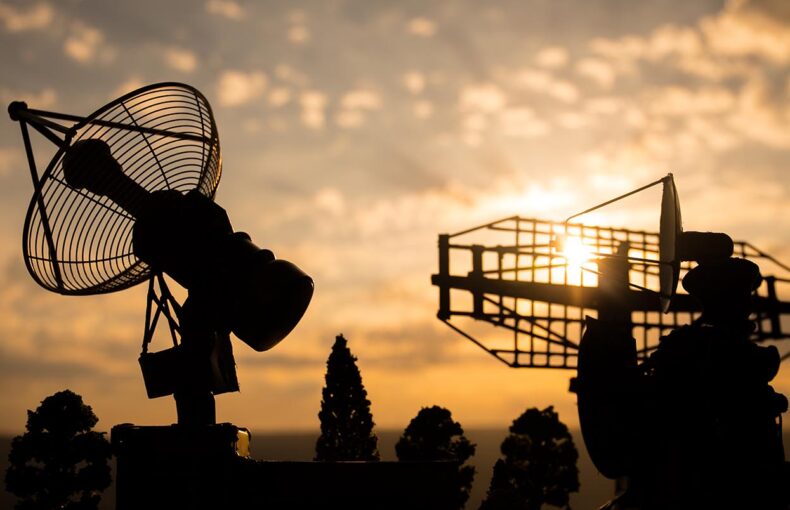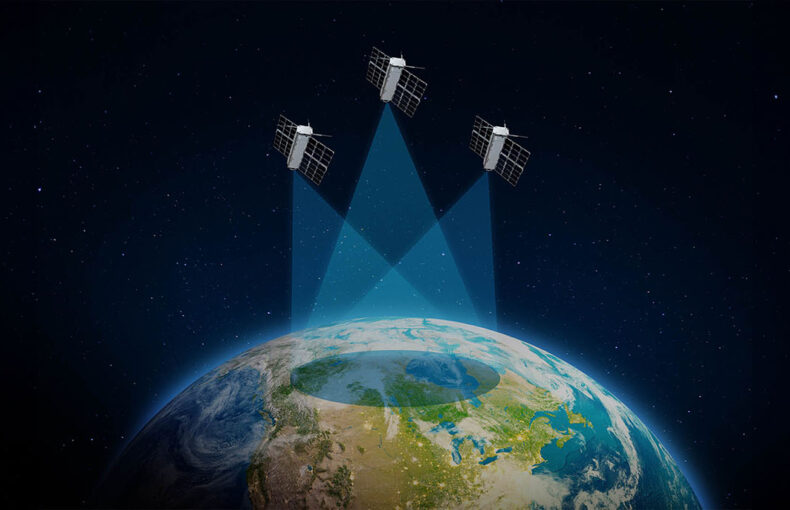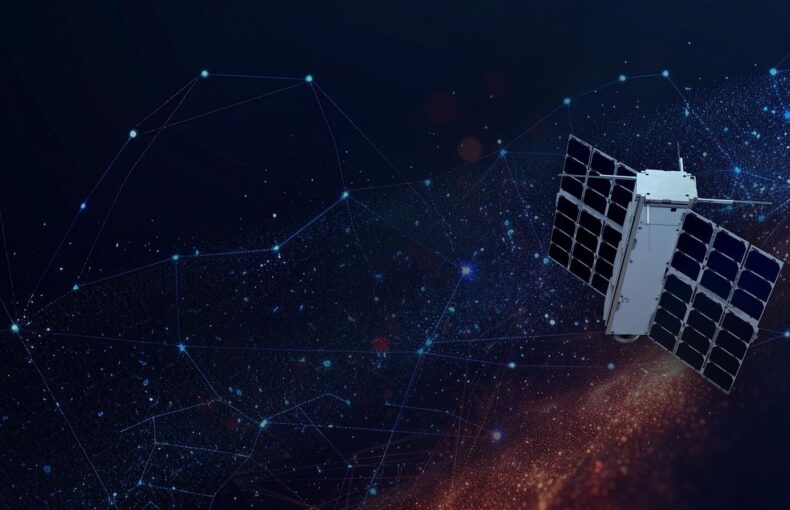The hidden risks of satellite phones: From lifelines to liability
- What are satellite phones?
- How do satellite phones work?
- The basic components of satellite phone systems
- Benefits of LEO-connected satellite phones
- Market overview of satellite phones
- Historical evolution of SAT phones
- Today's market value and projected growth
- The dark side of satellite phones: Communication for illicit purposes
- Mitigating the risk: Geolocating satellite phones with space-based RF detection
- Unmatched SAT phone detection & geolocation
Satellite phones. Modern technology that helps save lives and explore the most remote corners of the earth or devices used by the antagonist in your favorite crime movie?
While satellite phones are certainly used to aid things like search and rescue missions or scientific expeditions, they are increasingly used for nefarious purposes, typically by people in criminal or drug trafficking organizations.
With satellite phones proliferating at unprecedented rates due to their numerous applications, ready availability, and affordable costs, the demand for a more streamlined funnel of connectivity is growing fast. But while we expect to see the demand help drive our capabilities in military operations, scientific exploration, and industry development, we can also expect to see people and entities use the innovations for things not so good.
Below, we explore the growing satellite phone market, the benefits and problems we could see from the growth, and the solutions under development to help facilitate communication and geolocate SAT phone signals for the greater good.
What are satellite phones?
Satellite phones are much like how they sound: portable devices that offer connection via telephone, cellular, and other networks using satellites in space. While SAT phones are commonly used in emergencies and natural disasters, their reliability and availability have helped make them a valuable tool for many new scenarios and applications.
How do satellite phones work?
Satellite phones work in a pretty unique way, and until the last decade or so, the method seemed more or less out of reach for daily use.
Satellite phones transmit signals to small satellites in Low Earth Orbit (LEO), about 2,000 km above the Earth’s surface. From there, the signal is relayed to the nearest “gateway,” or land-based center, from where it is sent to the receiving phone (landline, cellular phone, or another SAT phone) anywhere on the surface of the earth where the signal can reach unobstructed.
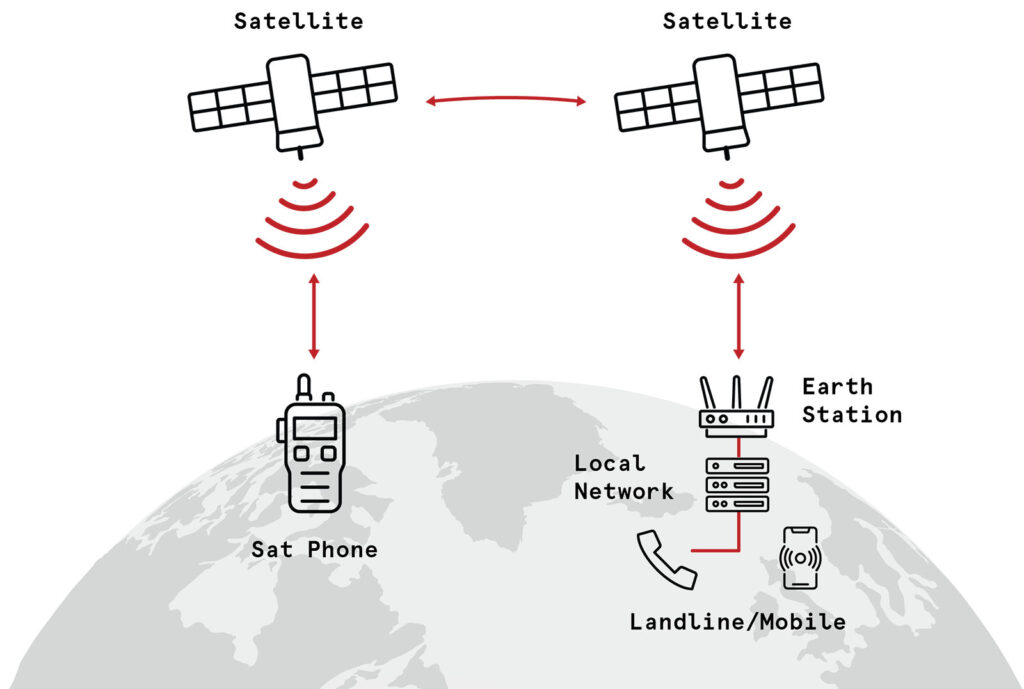
The satellite phone sends a signal to a satellite, traveling through the air as radio waves. The satellite, which is in low earth orbit (LEO), receives the signal and sends it either directly to a ground station or to another satellite for relay to a close ground station. Ground stations are connected to our common telephone networks, so the ground stations relay the signal to the common phone network, which routes the call to the user. If the receiver has a normal phone, that’s where the process ends. If the receiver also has a satellite phone, the process is reversed.
As long as there is a direct line of sight between the SAT phone, satellite, and gateway, they are able to function without issue.
Since LEO satellite networks typically orbit in a way that allows near-global coverage at any point in time, SAT phones are an undeniably useful tool to maintain communication, especially where typical cellular networks are unavailable.
The basic components of satellite phone systems
SAT phone systems are made up of several components that work together to ensure communication in some of the world’s harshest and most remote regions.
- Satellites: Satellites are the core of the SAT phone system, positioned in orbit to receive and relay signals from satellite phones to ground stations and receiving devices. Depending on the satellite phone system and its primary application, satellites can be based in Low Earth Orbit (LEO), Medium Earth Orbit (MEO), or Geostationary Orbit (GEO), with LEO being the most common in today’s growing market.
- Satellite phones (user terminals): The satellite phone is the device used by the individual who wishes to communicate with others somewhere else on Earth. Modern SAT phones are compact and equipped with antennas and processors to help ensure seamless communications via signal relays with satellites in orbit.
- Ground stations (gateways): Ground stations, or gateways, are the Earth-bound facilities that make the connection between the satellite and the receiving device. These stations are a crucial component of satellite phone systems, as they are the base that allows for streamlined communication and can be positioned in a way that there would rarely or never be obstructions that would prevent the satellite signal from being received.
- Satellite network center: Network centers manage the satellite constellations and oversee the operations of the signal relays and signal processing. Network management is largely automated, although the checks and balances are overseen by network professionals when issues arise.
Benefits of LEO-connected satellite phones
The growing number of LEO-based constellations and their advanced and innovative capabilities are driving global connectivity with satellite phone networks. Rather than using satellites in MEO or GEO, LEO satellites can deliver some distinct and competitive features.
Better signal quality
With less distance between SAT phones and satellites, LEO satellites offer improved signal quality with fewer opportunities for signal degradation. Clear and uninterrupted communication is a key component of making satellite phones a staple in modern communication.
Lower latency
Since LEO satellites are situated much closer to Earth than GEO satellites, the signals travel to their destination at a much faster speed. The quick relay allows for faster communication that can enhance real-time calls – something that is extremely important in high-risk scenarios.
Flexible coverage
Since most LEO satellites orbit the entire Earth in a matter of 1-2 hours, LEO constellations can provide near-global coverage and ensure there is always a satellite within view of the SAT phone. In some instances (think military operations), LEO satellites can be deployed to an area or region of interest to ensure further connectivity.
Cost-effective deployments
LEO satellites can be deployed into orbit at much lower costs than GEO satellites, primarily due to their compact size. GEO satellites require much greater precision and complex launches, making LEO satellites far more ideal for constellation development or constellation expansion.
Low power requirements
Compared to GEO satellites, LEO satellites require far less powerful ground-based antennas for seamless communication, mostly because of the close distance of orbit. The low power requirements also allow for smaller satellite phones that don’t require as much power to operate.
Market overview of satellite phones
While satellite phones were once considered niche tools used by explorers, military operatives, and remote fishermen, they have since re-emerged as valuable tools for a much larger audience.
Today, alongside the evolution of aerospace technologies and other related communications, satellite phones are used to connect the world’s most remote regions and overcome some of the more complex modern communications challenges.
On the opposite side of the coin are the nefarious uses for SAT phones. Satellite phones are used by entities like criminal organizations, shipping companies, and illegal fishing (IUU fishing) fleets to do everything from trafficking contraband to trading sanctioned goods.
With the increased value and applicability to everyday life, along with lower costs and higher availability, satellite phones are poised to show significant growth in the coming decade.
Historical evolution of SAT phones
Satellite phones were first conceptualized about half a century ago, in the 1970s, when space agencies began strategizing with telecommunications companies to enhance global communication using satellite technology. While none of the early-stage satellite phones were meant to be available for commercial use, they were aimed at military and research applications.
The first commercially available satellite phones made their debut in the late 1990s. The first major milestone was when Iridium Communications launched its constellation of 60+ satellites that provided global communications coverage, giving birth to the first commercial SAT phones. While the milestone was certainly an important part of history, these base-level satellite phones cost users around $1300 and up to $7.00 per minute of use – making it relatively out of reach for the everyday user. After spending nearly $5 billion to get the network up and running, Iridium was only able to capture about 55,000 users due to the bulky build, high device price point, and lofty cost of service.
In the early 2000s, satellite phone technology became more accessible and more advanced. Technological innovations led us to less bulky SAT phone builds, better coverage in some of the world’s most remote regions, and data services that included texting and email. While innovations were made to improve the satellite phone landscape, they did not boom enough to become mainstream.
From 2010 to 2020, even bigger innovations were made, and more players entered the commercially competitive landscape. Satellite phones have become compatible with smartphones, and smartphone technology could be integrated with satellite-driven capabilities. Inmarsat and Thuraya were two of the biggest players continuing development, although more entities were making their debut during this time.
Fast forward to today, and we are looking at a whole new era of satellite phone technology.
Companies like SpaceX, OneWeb, and Telesat are some of the newest players in the SAT phone game, all of which are operating constellations of small satellites in Low Earth Orbit (LEO). Since these companies operate in space with a narrowed scope of focus, they are able to innovate and provide even better coverage and reliability than companies in the past.
Low latency, high data speeds, and more expansive constellations are some of the biggest drivers of change, which ultimately translate to lower costs and broader availability for the daily user. The IoT solutions offered by these new-age constellations provide access to broader audiences and many new applications, which is helping drive safety and efficiency in numerous types of businesses, from tourism to exploration.
Today’s market value and projected growth
According to Allied Market Research, the global SAT phone market was valued at over $550 million in 2021, with projections showing a CAGR of 3.9% through 2031. At these estimates, the global satellite phone market will reach an estimated value of over $800 million by 2032.
The following sections outline why we are seeing such rapid growth and what is changing to make SAT phones more accessible and interesting to the public.
Growing number of applications
A big part of the projected growth in this market is due to a robust and growing network infrastructure and the mission-critical applications the networks can serve.
For example, year after year, we see more weather and climate-related disasters, all of which wreak havoc on global communications and public safety. With climate-related risk on a growing trajectory, nations around the world are looking to build network access and ensure communications, especially when disaster strikes.
Another aspect of the growth is military-based. Communication warfare tactics like GPS jamming, RF spoofing, and other types of RF interference are on a bee-line growth trajectory, leaving government and military entities scrambling to overcome the strategies. Since militaries need to maintain open and uninterrupted lines of communication at base or in conflict zones, satellite phones are valuable tools that help ensure public safety, national security, and mission success.
The market growth in civilian sectors over the past few years has come from a number of sources, although most of the growth has resulted from operations related to media, tourism, and other types of entrepreneurial businesses.
When operating a business or executing a project in remote areas, rarely explored parts of the world, or conflict zones, conventional cell coverage is normally unreliable, at best. Even when coverage is available in remote or hard-to-reach areas, the financial costs involved with connectivity are often high. Using satellite-based communication helps build resilience to local or regional communications challenges, ultimately improving the safety and reliability of an operation or activity.
Increased coverage and reliability
With a rapidly increasing number of space-focused entities and satellite constellations in space, particularly those operating in LEO, the coverage and reliability of satellite phone networks have grown tremendously. Not only are some satellite constellations expansive enough to provide near-global coverage autonomously, but some satellite services now have the capability to be maneuvered and set on course to satisfy unique coverage demands.
While most consumer satellite phone networks aren’t manually controlled, satellites used for things like military communications are rerouted in high-stakes scenarios, operations in remote areas, or conflict zones where threats like GPS jamming and GPS spoofing exist.
Affordability and accessibility
Part of what makes the modern satellite phone and its network so accessible and affordable for the modern consumer is the technological advancements. Not only are we able to build smaller, more capable, and more deployable satellites, but we are able to do it on an unprecedented scale.
Modern satellites, often built at the size of a toaster or microwave, are deployable much easier and faster than in the past. Since both rockets and satellites are being built at much lower costs and can enter orbit more easily and on a much faster timeline, we are seeing the enhanced communications capabilities grow by the day.
With some of the biggest satellite players in the game equipping satellites with SAT phone-capable technologies, we are now able to service the modern consumer with reliable communications at the furthest corners of the globe.
Rather than relying on costly ground communications infrastructure, companies can service the user from a global satellite constellation, moving past challenges involved with rugged geography, remote regions, and countries with controlled regulations on communication.
Advanced features
Many advanced features are driving the market growth for consumer satellite phones, with one of the most important features being GPS and location service integration.
Modern SAT phones come with built-in GPS, which allows the user to track or send their location to others in moments of distress or danger. GPS features are particularly important for scenarios like scientific expeditions, open ocean fishing operations, and search and rescue, although GPS can be valuable in a wide range of different situations.
One thing to consider is that even though satellite phones can send and receive signals in nearly every part of the world, GPS may not function in certain GPS-denied environments.
Another important feature of modern SAT phones is their advanced security features, especially for those involved in military, trade, or other information-sensitive positions. Data encryption, secure voice and text communications, and access security all make the modern SAT phone a valuable tool to operate without the threat of intrusion.
IoT integration is another feature that has pushed the modern satellite phone into an exciting new era. Since satellite phones can be integrated with all sorts of IoT devices, users are able to monitor, control, and adjust everything from agricultural equipment to supply chain logistics. As these capabilities continue to grow, we can expect to see more streamlined and affordable pathways to operate and navigate the modern landscape.
The dark side of satellite phones: Communication for illicit purposes
With the near-global coverage and seamless communication benefits of satellite phone networks, SAT phones are being used more and more for illegal and illicit purposes. While satellite phones make great assets for good, they can also be deployed with relative security for those looking to fly under the law’s radar or bypass local and regional policies and regulations.
Below, we look at just some of the ways SAT phone networks are misused by individuals, criminal organizations, and more.
Drug, weapons, and human trafficking
Traffickers of all kinds have a long history of employing new and innovative methods to ensure the success of their operations. With the rise of satellite phones, namely due to their easy access and affordability, it’s no surprise that drug, weapon, and human traffickers are using the technologies to their advantage.
Traffickers are already using strategies like dark shipping and semi-submersibles to transport their products across large areas of the ocean undetected. As you might expect, cell coverage can be non-existent in some parts of the sea, and standard cellular or radio communications make it easy to get caught by authorities. By using satellite phones to communicate during illegal routes, traffickers are able to bypass some of the historical challenges they’ve faced.
One recent news story from the Washington Post describes how drug trafficking organizations used the Galápagos Islands as a stop-off point to refuel their fast boats en route with cocaine cargo. One man was interviewed and explained how the organization would use satellite phones to organize trafficking routes. Authorities have since mapped the alleged satellite phone signals of cocaine smugglers in the area, which can be seen on the map below.
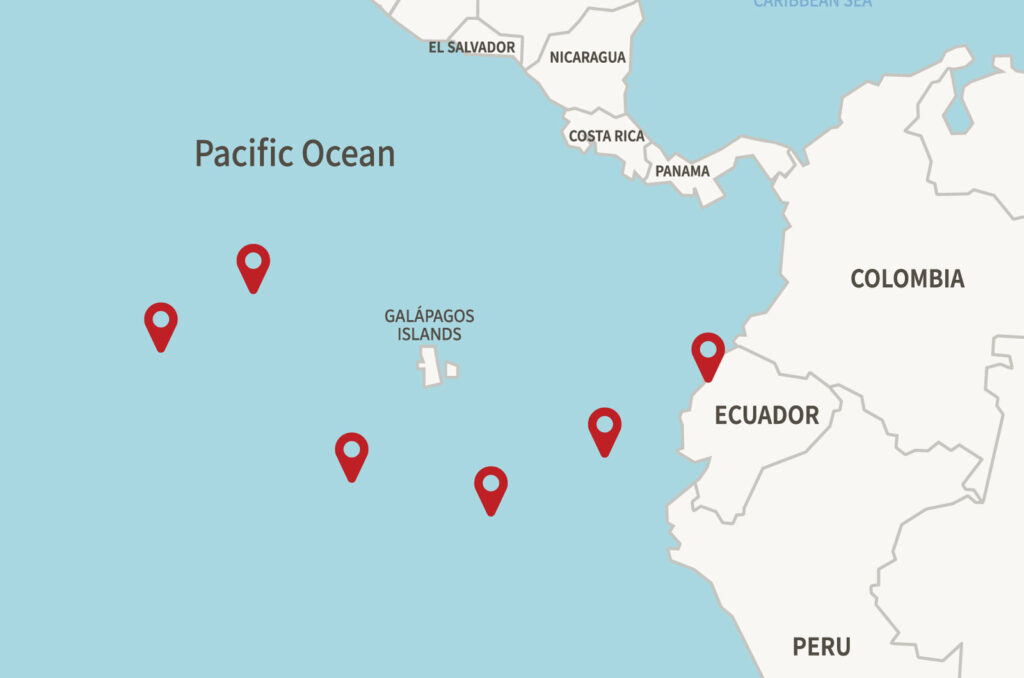
Terrorism
With the hard-to-track nature of satellite phones, terrorist groups have also been known to employ the technology for their benefit. Terrorists use SAT phones to plan attacks, coordinate strikes, organize with other members of the group, and evade detection by authorities.
In 2022, militant groups in Kashmir, a remote and mountainous region in the north of India, were reportedly using Iridium satellite phones to operate under the radar. According to the source, the SAT phones were aiding the terrorists in evading detection and capture during the night. According to officials, Iridium satellite phone signatures were detected in the months leading up to the news story, with some signatures even seen south of Kashmir – showing just how widespread the use of satellite phones has become within the particular terrorist organization.
Illegal, unregulated, and unreported (IUU) fishing
Satellite phones play a key role in illegal fishing operations, primarily due to the near-global coverage that can be used in even the most remote parts of the ocean.
Often, illegal fishing fleets will only operate in areas where they can maintain contact with their organization or at least keep an eye on authorities or other potential threats. Since your standard methods of communication are easily detectable by maritime authorities, satellite phones offer an easy and affordable alternative to staying connected.
For example, if someone in the organization is monitoring the area for authorities and sees someone coming for one of their ships, they can quickly contact that ship and have them exit the area before the authorities arrive.
Another use is to manage fleets or operations. Communication can be made from far, far away, and the “controller” can manage multiple vessels in a fleet to coordinate efforts for the biggest ROI. Crews can coordinate with each other, share valuable intel on catch, and provide information on fishing grounds that might otherwise go uncommunicated.
Mitigating the risk: Geolocating satellite phones with space-based RF detection
In order to secure Earth-bound domains and protect the public from the illegal and illicit use of satellite phones, we must look to a similar area for answers: Space.
Geolocating satellite phones from space involves locating the Radio Frequency (RF) signals from the device. Basically, any device that uses radio signals to operate something called Radio Frequency data, otherwise known as RF emissions. These signals can be geolocated from space with a combination of satellites, ground systems, and complex geolocation techniques that have been revolutionized by some of today’s biggest and most innovative space-as-a-service companies.
To understand better, let’s take a closer look at RF geolocation below.
Satellite geolocation
Satellites equipped with various types of RF payloads are already operating by the dozens in space. Spire’s constellation, for example, uses its satellites in various ways for RF geolocation. Spire’s constellation can geolocate RF signals with a single satellite (although less efficient), a cluster of two satellites, or a cluster of 3-4 satellites.
The most effective and efficient geolocation method is using three or more satellites, as the signals can be triangulated faster and more accurately. With three or more satellites, the area of interest (AOI) can also be increased, so rather than using a precise tip-and-cue method for narrowing the area under observation, a broader view can be used to find the frequency of interest.
One of the biggest upsides to satellite-based RF geolocation is that with a fully deployed RF constellation, users can make highly accurate RF collections in near real-time. This allows the user to take action without hesitation, whether that’s deploying authorities to a location or strategizing for further surveillance. In scenarios involving drug and weapons trafficking or terrorism, time is of the essence, and every second counts in order to mitigate the fallout.
Satellite geolocation techniques
Numerous techniques are available to help geolocate RF signals from space, a few of which are outlined below.
Triangulation
Triangulation is a process used with multiple satellites that measure the angles and time of delay between signals received by the sensors at known locations, which are part of each satellite’s payload. By using the measurements and calculating the data accordingly, the position of the SAT phone can be determined quite accurately.
While RF signals from satellite phones can be tracked with the use of ground stations, satellites offer the most accurate and efficient pathway to geolocation.
Time Difference of Arrival (TDOA)
Simply put, TDOA measures the time it takes a signal to reach multiple known receivers. In this case, the receivers are aboard the LEO satellites. By comparing the time differences at each receiver, it is possible to determine the location of the RF signal emitted by the SAT phone.
The incredibly precise time clocks used in TDOA measurements are key instruments for success in this method.
Frequency Difference of Arrival (FDOA)
While TDOA measures the time it takes for signals to reach a receiver, FDOA measures the “Doppler Shift” in the frequency of the signal as it relates to each satellite receiver. Frequency shifts are caused by the movement between the satellite phone and the satellite receiver over time between the data at each timestamp.
By analyzing these shifts and calculating them between each receiver, RF signals are able to be geolocated accurately.
Unmatched SAT phone detection & geolocation
Spire owns and operates one of the largest LEO satellite constellations that deliver RF intelligence, serving world-class clients like NASA, NOAA, and the European Space Agency (ESA). We’ve cemented our role as an industry leader in RF detection and geolocation by offering customized, scalable solutions for clients in sectors that serve climate, maritime, aviation, and space reconnaissance needs.
The RF payloads aboard our proprietary satellite constellations capture a wide range of frequency bands, offering near-global coverage for all types of devices, from VHF marine radios to state-of-the-art satellite phones.
VHF marine radios
Emergency radiobeacons
UHF push-to-talk radios
L-Band satellite mobile devices
S-Band marine navigation radar
X-Band marine navigation radar
GPS interference
UHF flex
VHF flex
Our tailored solutions for RF intelligence offer a flexible strategy for deploying mission-specific technologies, including Spire-hosted payloads and total satellite operations management. The customizable approach to space-based RF intelligence allows entities to pursue mission-centric goals, fully supported by Spire’s extensive RF infrastructure and operational expertise.
Still, RF data alone isn’t what makes Spire stand out in the realm of RF intelligence. Spire’s unmatched value-add is the ability to mix and match various types of data, including optical and SAR, to create hyper-focused intelligence that goes beyond waning industry norms.
Theresa Condor, COO of Spire, said it best, “So it’s not just, “Oh, we do analysis on optical imaging.” It will be, “We do analysis and help a business come up with an understanding and decision that merges optical and SAR and various types of RF data.”
It will come down more and more to, ‘What is the problem, and how is it helping arrive at the right decision to take in a timely way,’ and less about what the technique is.”
 Written by
Written by
